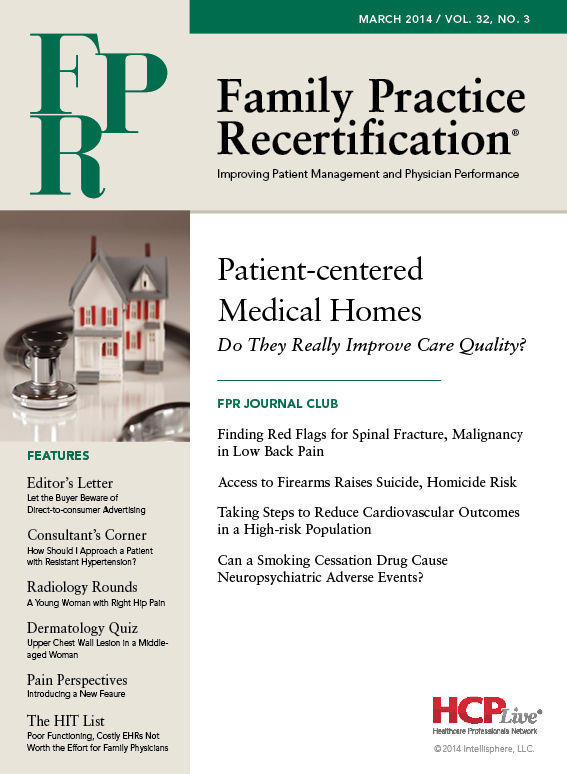Publication
Article
Family Practice Recertification
How Should I Approach a Patient with Resistant Hypertension?
Author(s):
The true prevalence of resistant hypertension is unknown, but it is estimated to occur in up to 20% of patients with chronic hypertension.

You see a 60-year-old African-American female patient for the first time for an annual checkup. Her past medical history is notable only for a 15-year history of hypertension and a history of having undergone a diagnostic laparoscopy 30 years ago for infertility. Her current medications are hydrochlorothiazide 25 mg daily, valsartan 320 mg daily, and amlodipine 10 mg daily. Physical examination is remarkable for a blood pressure of 177/90 mm Hg, pulse of 67 bpm, and a body mass index (BMI) of 28.41 kg/m2.
While the patient’s lung exam is clear, her fundoscopic exam reveals arteriovenous (AV) nicking and her heart exam is notable for the presence of an abnormal diastolic heart sound (S4). However, she has no flank or epigastric bruits.
The patient reports that over the past year, her blood pressure has consistently been >150/95 mm Hg when checked at the doctor’s office.
Does she qualify for the diagnosis of resistant hypertension?
According to the Seventh Report of the Joint National Committee on Prevention, Detection, Evaluation, and Treatment of High Blood Pressure (JNC 7), resistant hypertension is defined as the failure to achieve a blood pressure of at least 140/90 mm Hg — or at least 130/80 mm Hg for patients with diabetes or renal disease — despite adherence to treatment with full doses of at least 3 antihypertensive medications, including a diuretic. So, by that definition, this patient does have resistant hypertension.
The true prevalence of resistant hypertension is unknown, but it is estimated to occur in up to 20% of patients with chronic hypertension. Older age, obesity, and high baseline systolic blood pressure are among the strongest risk factors for resistant hypertension. In addition, African-American patients and women are more likely to have resistant hypertension.
What are possible causes of resistant hypertension?
In general, cases of resistant hypertension can be grouped into:
- Patient-related causes, such as non-adherence to medications
- Physician-related causes, such as failure to titrate medications
- Interfering substance, such as excessive salt intake
- Secondary hypertension, such as obstructive sleep apnea (OSA)
What drugs are common causes of resistant hypertension?
Drugs that lead to salt and water retention are among the most common causes of drug-induced resistance. Therefore, non-steroidal anti-inflammatory drugs (NSAIDs), glucocorticoids, and oral contraceptives are common causes of drug-induced resistant hypertension. Another class of medications that may induce hypertension is the sympathomimetic agents, which are found in many over-the-counter cold preparations or diet pills.
The patient states that she rarely forgets to take her medication, but when she does, it is generally when she goes on vacation. She said she tries to watch the salt in her diet and only occasionally uses the saltshaker to season her food. How would you evaluate her salt intake?
If you suspect the patient is ingesting excessive sodium, this can be assessed via 24-hour urine collection. The amount of sodium needed for normal physiologic functioning is small, yet humans typically ingest sodium in much larger amounts. Under normal conditions, the kidneys serve as the sole mode of excretion of excess sodium. Therefore, the amount of sodium excreted in a 24-hour period is a very good estimate of the amount of sodium ingested.1 If, in fact, sodium excess is contributing to this patient’s resistant hypertension, then blood pressure control can be improved with firm sodium restriction.
What dietary and lifestyle instructions would you offer this patient?
Lifestyle modification has been shown to be a very successful treatment for hypertension or prehypertension. According to the JNC 7, appropriate modifications include reducing dietary sodium to <2.4 g per day; increasing exercise to at least 30 minutes per day for 4 days a week; limiting alcohol consumption to 2 drinks or less per day for men, or 1 drink or less per day for women; following the Dietary Approaches to Stop Hypertension (DASH) eating plan, which is high in fruits, vegetables, potassium, calcium, and magnesium, but low in fat and salt; and achieving a weight loss goal of 10 lbs or more.
What is the role of ambulatory blood pressure monitoring (ABPM)?
ABPM is useful in several clinical situations, including:
- Excluding white coat hypertension
- Confirming a diagnosis of borderline hypertension
- Identifying nocturnal hypertension
- Recognizing hypertensive patients who are resistant to treatment
The patient follows your lifestyle recommendations. Based on home blood pressure monitoring, her blood pressure ranges from 140-160/86-96 mm Hg. What secondary causes of hypertension should be considered?
There are many secondary causes of hypertension, such as chronic kidney disease (CKD), aortic coarctation, Cushing syndrome, chronic steroid therapy, pheochromocytoma, primary hyperaldosteronism, renovascular hypertension, OSA, and thyroid or parathyroid disease. Some causes like pheochromocytoma are very rare, while others such as OSA are more recurrent. Although it was initially considered a rarity, primary aldosteronism is now considered one of the most common causes of secondary hypertension.
What screening studies would you order routinely?
Basic laboratory studies indicated for the initial evaluation of a hypertensive patient may include urinalysis, fasting blood glucose, hematocrit, and estimated or measured glomerular filtration rate (GFR). In the absence of a bruit or other signs of potential renal artery stenosis, tests like a magnetic resonance angiography (MRA) would not be immediately indicated. Assessment for hyperaldosteronism through an aldosterone-renin ratio (ARR) would also not be immediately indicated if the basic laboratory results were normal; however, an ARR may be performed later.
How common is primary hyperaldosteronism?
Although initially considered a rarity, primary aldosteronism now is considered one of the more common causes of secondary hypertension. Primary aldosteronism affects 5—13% of patients with hypertension. Patients with hypertension and hypokalemia, as well as many patients with treatment-resistant hypertension, should be screened for primary aldosteronism.
How would you screen for hyperaldosteronism?
By measuring the plasma ARR. Because both aldosterone and renin levels are affected by many factors, the following recommendations2 are used when assessing the ARR:
- Hypokalemia is corrected after measuring plasma potassium in blood collected slowly using a syringe and needle, avoiding fist clenching during collection, waiting at least 10 seconds after tourniquet released (if it was used to achieve insertion of needle), and ensuring separation of plasma from cells within 30 minutes of collection.
- Patients are encouraged to liberalize sodium intake, rather than restrict it.
- Medications that significantly affect the ARR are withdrawn at least 2 weeks before testing for beta-blockers, clonidine, methyldopa, NSAIDs, angiotensin-converting-enzyme (ACE) inhibitors, angiotensin II receptor blockers (ARBs), and dihydropyridine calcium blockers, and at least 4 weeks before testing for diuretics, including spironolactone.
- As necessary to maintain hypertension control, other antihypertensive medications that have lesser effects on the ARR — such as prazosin and slow-release verapamil with or without hydralazine — are commenced.
- Contraceptive agents are not withdrawn unless confident of an alternative effective contraception.
How is the ARR interpreted?
The renin-angiotensin-aldosterone system is one of 2 systems — the other being the sympathetic nervous system — that are most intricately involved with blood pressure regulation. Plasma renin and plasma aldosterone levels are tightly coupled as renin catalyzes the rate-limiting step in the production of angiotensin II, an important regulator of aldosterone synthesis. Because of this, the information gained from either level individually is not necessarily meaningful, and in fact may be misleading. But when those 2 levels are evaluated in combination as a ratio, this provides information necessary for the evaluation of primary hyperaldosteronism.
Many investigators have recommended the use of the ARR to screen for primary hyperaldosteronism, although varying cutoff points have been suggested for this purpose. However, data suggests a cutoff value of 23.6 ng/dl per ng/(ml·h) will have a sensitivity and specificity of 96.8% and 94.1%, respectively. Higher cutoff values will yield higher specificity, but lower sensitivity. Therefore, using an ARR cutoff >23.6 ng/dl will identify most cases of primary hyperaldosteronism with a low false-positive rate.3
When would you initiate a trial of treatment with an aldosterone antagonist and how would you do so?
There are no standard guidelines for initiating a course of an aldosterone antagonist in cases of resistant hypertension unless there is documentation of hyperaldosteronism. However, some investigators have hypothesized that this might be useful. Mari K. Nishizaka, MD, and colleagues tested this theory by assessing the blood pressure response at 1 month, 3 months, and 6 months of follow-up after adding low-dose (12.5-50 mg) spironolactone to the antihypertensive regimen of 76 subjects with resistant hypertension. 4
Before initiation of spironolactone therapy, renin-aldosterone status was characterized in terms of plasma-renin activity and 24-hour urinary aldosterone excretion. All subjects were on multidrug regimens that included a diuretic, an ACE inhibitor, or ARB. The mean dose of spironolactone at the end of 6 months follow-up was 30 mg daily.
The addition of low-dose spironolactone was associated with a mean decrease in blood pressure of 21±20 mm Hg/10±14 mm Hg at 6 weeks and 25±20 mm Hg/12±12 mm Hg at 6 months follow-up. The reduction in blood pressure was similar in subjects with high urinary aldosterone excretion and those with normal or low aldosterone excretion.
Would you consider switching the patient’s diuretic to chlorthalidone?
While hydrochlorothiazide is the most commonly used thiazide diuretic in the United States, chlorthalidone has been more extensively studied in clinical trials, including the Hypertension Detection and Follow-up Program (HDFP), Multiple Risk Factor Intervention Trial (MRFIT), Systolic Hypertension in the Elderly Program (SHEP), and Antihypertensive and Lipid-Lowering Treatment to Prevent Heart Attack Trial (ALLHAT). Chlorthalidone is approximately 1.5-2 times as potent as hydrochlorothiazide, and it has a longer duration of action. However, no studies have directly compared the 2 agents, so there is no clinical data to suggest 1 agent should be preferred over the other.
References
1. Luft FC, Fineberg NS, Sloan RS. Estimating dietary sodium intake in individuals receiving a randomly fluctuating intake. Hypertension. 1982;4(6):805-8. http://www.ncbi.nlm.nih.gov/pubmed/7141607.
2. Stowasser M, et al. Laboratory investigation of primary aldosteronism. Clin Biochem Rev. 2010 May;31(2):39-56. http://www.ncbi.nlm.nih.gov/pmc/articles/PMC2874431/.
3. Bravo EL, Rafey MA. New insights into the role of the aldosterone/rennin ratio in elevated peripheral and central blood pressure. JACC. 2010; 55(19):2181-2. http://content.onlinejacc.org/article.aspx?articleid=1142804.
4. Nishizaka MK, Zaman MA, Calhoun DA. Efficacy of low-dose spironolactone in subjects with resistant hypertension. Am J Hypertens. 2003 Nov;16(11 Pt 1):925-30. http://www.ncbi.nlm.nih.gov/pubmed/14573330.
About the Author

Karol Watson, MD, is Professor of Medicine/Cardiology at the David Geffen School of Medicine at UCLA. She is also Co-Director of the UCLA Program for Preventive Cardiology. All questions were posed by Family Practice Recertification Editor-in-Chief Martin Quan, MD.






